| |
|
|
|
|
A number of City churches destroyed in the German bombing
of 1940-41 were never rebuilt. St Swithin was one of
them, and along with St Mildred Bread Street was a sad
and serious loss. The church was prominently placed,
standing end on into Cannon Street opposite the station
and almost backing onto St Stephen Walbrook, with St
Swithin's Lane running to the east of it, connecting
Cannon Street to King William Street. St Swithin, or St
Swithun as it is sometimes recorded, was best known for
having the London Stone behind a grill at its southern
end. The stone was a Roman milestone, or King Lud's
marker for the centre of the City, or a pagan altar -
amongst other ideas, depending on who you believed. What
is certain is that it became a physical symbol of the
City, and the rebel Jack Cade struck it with his sword in
1450 as an act of proclaiming himself as master of
London. In the 17th Century it seems to have had some
connection with the dispensing of justice - poor quality
goods, for example, were ordered to be broken up on the
London Stone.The 15th
Century church was destroyed in the Great Fire. Wayland
Young says that Wren used stone from the old church for
the new one, and describes Wren's church as a most
subtle and beautiful building. It was more or less a
cube, with the tower at one corner. But from the top of
the cube rose an octagonal dome, and from the top of the
tower a tall octagonal spire. The tower, which was
150 feet tall, was at the north-western corner with the
burial ground beyond it, raised above street level. The
church was famous for its huge pulpit, which went in the
substantial restoration of 1869, which included the
setting of Venetian-style tracery into Wren's windows -
the architect, Woodthorpe, seems to have been copying
what George Gilbert Scott did more successfully at St
Michael Cornhill ten years earlier.
On Sunday 29th December 1940, the
church was locked up after the morning service. That
evening, waves of German planes crossed the City laying a
carpet of incendiaries and high explosives. There was a
strong wind, which fanned the flames, and many of the
firewatchers who customarily took up duty on the City
buildings were away for the Christmas holidays. The
Corporation had requested that buildings be left unlocked
to aid fire-fighters, but in general this did not happen.
In any case, all efforts were put into saving St Paul's
Cathedral, and the thirty-five acre firestorm between
Cannon Street and Old Street was more or less left to
burn itself out. Eighteen City churches were lost that
night, and a thousand people killed.
When the Blitz was over, the tower
still stood without its spire, the church still stood
without its roof. The site was overgrown with rose bay
willow-herb while the authorities decided if St Swithin
would be one of the City churches to be rebuilt. In the
end it wasn't, and the remains were bulldozed in 1962.
St Swithin's Lane survives, and the
burial ground survives too, though you'll have to find
it. Go up Salters Hall Court, which ran to the west of
the church, and it opens out into a raised garden beneath
the vast glass and steel Walbrook Building. This was the
burial ground. The original entrance gates are still in
situ. The garden itself is modern in style, with
beds of slate around the trees and a concrete pathway. It
is home to the curious 2001 memorial to the Welsh
nationalist heroine Catrin Owain Glyndwr, who was
executed in the Tower of London in 1413 and buried here.
The memorial, by Nic Stradlyn-John and Richard Renshaw,
looks like something between a flame and a penguin.
Beyond, Mr Nathaniel Thornton, formerly of Lisbon and
late of Bruxelles, merchant, buried here in 1839,
sleeps on under his headstone.
Simon Knott, December 2015
location: Salters Hall Court, Cannon Street
EC4 4/060
status: churchyard only
access: gated, open during daylight hours
        
Commission
from Amazon.co.uk supports the running of this site
|
|
|
|
|
|



